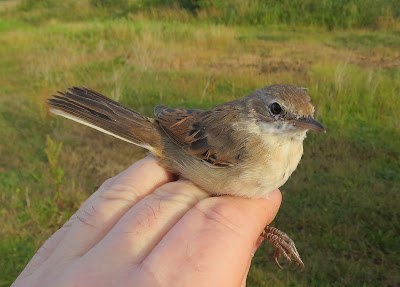Swallow
We ringed 80 birds as follows (recaptures in brackets):
Reed Warbler - 1 (1)
Swallow - 79
We also controlled two Swallows that have been safely input into IPMR but if L863614 or D466408 are yours please let me know.
What was also interesting last night was the number of adults amongst the juveniles. Normally when the roost is made up of large numbers of Swallows the percentage of adults is low. However, when the roost starts to decrease in size or break up due to poor weather the percentage of adults in the catch increases. Based just upon the birds that I handled below are the percentage of adults ringed by date:
18th July - 6%
21st July - 0%
24th July - 0%
29th July - 22%
On 18th July the roost was just starting to build, 21st & 24th at its peak, and 29th July numbers had reduced as stated above due to inclement weather. This is probably due to a number of factors; the ratio of adults to juveniles moving that day, juveniles less likely to move when the weather is poor and perhaps that the adults have learnt that there is a safe roosting place and are prepared to travel further even when the weather is unsettled.
Prior to us commencing our Swallow catch a Peregrine flew past us carrying prey; a Swallow perhaps? We will be back at the Swallow roost again later in the week, but how well we'll catch will depend on what the weather is like between now and then. I'll keep you posted.




























